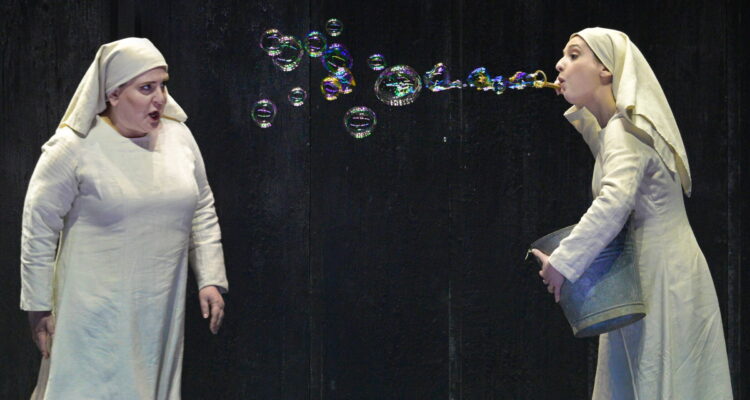Francis Poulenc’s 1957 “Dialogues des Carmélites” is one of the few operas written in the second half of the 20th century that are regularly performed in opera houses. Beautiful tonal music and a powerful story account for this. However, this is the first time the French opera about nuns during the Reign of Terror period of the French Revolution is performed at the Israeli Opera. It is a dramatization of a true bit of history about 16 nuns that were declared guilty of being enemies of the revolution and sent to the guillotine.
A screenplay that was never filmed served as the basis for Poulenc’s libretto. It follows Blanche, daughter of Marquis de la Force, who enters a Carmelite convent in an attempt to flee the violence aimed at aristocrats. When the convent is nationalized and the nuns are ordered to give up their religious habits, they decide to become martyrs. Blanche flees again, but in the last minute she joins her friends, who are slaughtered one by one as they sing Salve Regina.
Director Oliver Py, together with set and costume designer Pierre-Andre Weitz, decided to emphasize the darkness of the story and opted for a spare, all grey, modern production. The walls (in both Blanches home and the monastery) and the trees in the garden, as well as the nuns’ habits – everything is grey, with a bit of black and white here and there. The lighting, designed by Bertrand Killy, is very low key and this harsh look makes the first act a little difficult to watch.
The scene in which Madame de Croissy, the prioress of the monastery, is questioning her commitment to God as she is slowly dying in her bed, was clearly inspired by cinematic language. At first sight it is quite impressive. Her bedroom is designed upright as if filmed from a birds’ eye view, an angel which in movies often represents a godlike point of view. However, in movies such suggestive shots are short, while here the whole scene is designed like that, and the symbolic overpowers the potential drama in the scene.
The second and third act are more interesting dramatically and musically, and it seems that they inspired the above mentioned artists to create some more striking images. The prison scene is designed with stripes of light in the dark, and later the back wall is pulled aside to reveal a starry night, that looks upon the powerful final scene. Still, the costumes could be more imaginative. Too many modern productions these days seem go for black and white, and it has become a cliché.
What makes this production worth while attending is the music and the beautiful singing by mostly Israeli singers. Though she looks a bit old for the part of the novice nun, Soprano Yael Levita sang very well in the role of Blanche. Romanian Baritone Ionut Pascu, who performs regularly with the Israeli Opera, was commanding as her father the Marquis. Soprano Shira Patchornik was touching as her fellow novice, Sister Constance, who tells Blanche about her dream that the two of them will die young together. Shay Bloch and Alla Vasilevitsky were very good as the old and new prioresses of the monastery, and Anat Czarny was superb as Mother Marie who proposes that the nuns take a vow of martyrdom, but ends up not dying with them, despite her pleas to the chaplain. Especially beautiful were the harmonious prayers sung by all the nuns together.
The orchestra, conducted by Asher Fisch, sounded sharp but sometimes covered the singing. All in all, this is an impressive introduction to this opera, though a classic production might have been a better choice.
Music by Francis Pulenc
Director: Oliver Py
Revival Director: Daniel Izzo
Set and Costume Designer: Pierre-Andre Weitz
Lighting Designer: Bertrand Killy
Conductor: Asher Fisch
Sung in French with Hebrew and English surtitles
Cast includes Yael Levita, Anat Czarny, Shay Bloch, Alla Vasilevitsky, Ionut Pascu
The Israeli Opera Tel-Aviv-Yafo האופרה הישראלית תל-אביב-יפו
Running time: 2hrs 45mins including interval

